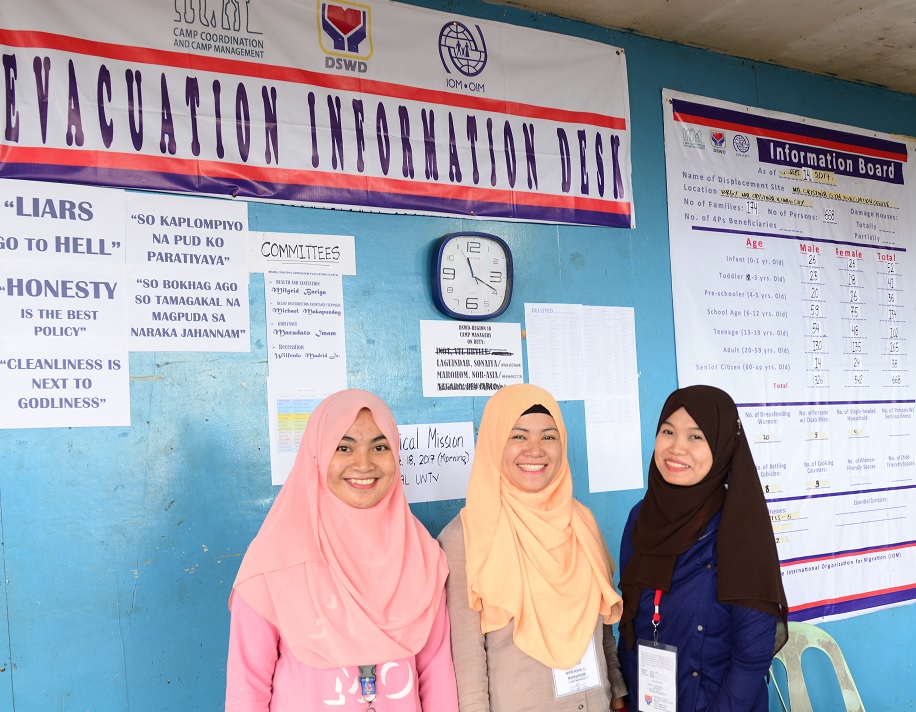
End of conflict declared in Marawi as humanitarian needs continue
On 23 October, 154 days after the conflict began in Marawi City, Defense Secretary Delfin Lorenzana issued a press statement announcing the end of combat operations. This came one week after confirming the deaths of Isnilon Hapilon, the Abu Sayyaf Group leader who led the armed revolt that instigated the conflict, and Omar Maute, one of the leaders of the local non-state armed group that has been a main party to the conflict.
The Department of Social Welfare and Development (DSWD) officially reports a total displacement of 353,921 people as of 22 October, with an additional 3,648 people being validated. With reports of some displaced people excluded from DSWD’s Disaster Assistance Family Access Card (DAFAC) registry, Task Force Bangon Marawi has requested local authorities to revalidate the DAFAC registrations and submit revised lists to DSWD.
Some people have started to return to areas of Marawi City unaffected by the conflict. The first area to be cleared comprised ten barangays near Sagonsongan, the proposed transition site, where most residents did not evacuate. The second included ten barangays on the western side of the Mindanao State University campus. The most recent area to be opened comprises nine barangays in the area of the provincial capitol northeast toward the Agus River. The city government will review the return process and make improvements for successive clusters of barangays to be cleared for returns The Government says it will provide a one-month’s supply of food and non-food items to those who return. The Marawi City government is leading the return process, including preparing for psychosocial support services to returnees.
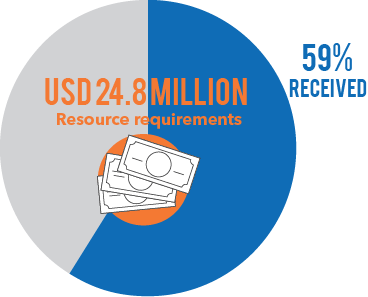
Source: OCHA
International contributions have reached $14.7 million as of 22 October, against the total requirement of $24.8 million
Humanitarian and transitional needs continue
Government, NGO and international responders have re-assessed the priority humanitarian and transitional needs of those still displaced. The Mindanao Humanitarian Team developed a sector implementation plan that identifies needs, recommended responses and gaps for October through December. (The term “sector” is being used to distinguish the activities from the government-led clusters, which were formally deactivated on 12 August.) The plan was presented to the task force and DSWD leadership on 7 October.
The sectors will strengthen coordination with responding government agencies and look to access additional funding that will enable humanitarian assistance to continue beyond December 2017.
So far, transportation resources and logistics facilities have been inadequate to meet the humanitarian needs of those displaced. Concerns have also been raised by local authorities regading the release of national funding, which is delaying the immediate procurement and smooth distribution of relief goods needed for the response.
While the needs of those staying in evacuation centres still require attention, people living with host families and in remote areas also need to be prioritized for assistance. More focused support is also required for children with special needs, orphans, at-risk children, out-of-school youth and child-headed families.
Access to health services
The health sector notes 40 per cent of evacuation centres do not have regular access to essential health services. There is no mobile outreach, either, for many municipalities hosting people displaced by the conflict. Sector partners are providing reproductive health services, peer counselling on adolescent sexual and reproductive health, and mental health and psychosocial support services in schools, evacuation centres, and host communities.
A limited number of available trained health workers is affecting the coverage of emergency nutrition services and information for severe acute malnutrition cases. The targeted supplementary food programme is only reaching a limited number of moderately malnourished children. Monitoring and surveillance for severe acute malnutrition in remote host communities, supplemental feeding and targeted cash transfers will be needed for the next 6 to 12 months.
Continuing food and agriculture support
Food security and agriculture sector partners are conducting an emergency food security assessment that will provide a clearer indication of the immediate needs in the affected areas. The sector will assist 7,800 affected families (39,000 people) with food items and proposes to assist 60,000 students with emergency school feedings.
Ensuring water is safe in displaced communities
While gaps remain in replenishing water treatment chemicals, repairing existing water sources, and monitoring water quality in host family households, technical assessments for water, sanitation and hygiene (WASH) are being conducted in various municipalities. Government agencies and sector partners are also desludging septic tanks and constructing temporary septic treatment sites and latrines. More work is needed on training local government staff and volunteers, mobilizing community clean-up campaigns, and supporting local governments on solid waste management.
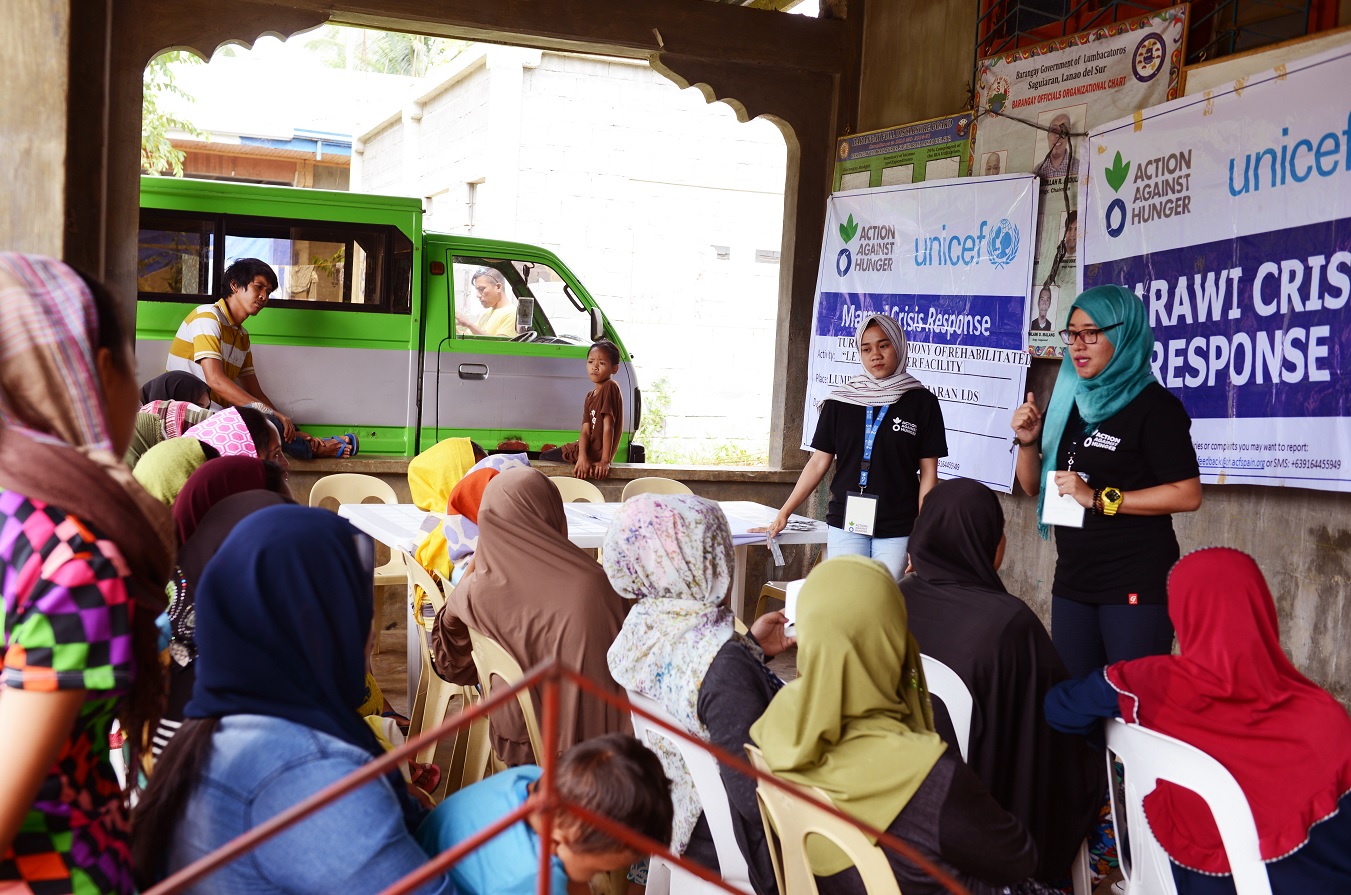
Credit: OCHA/G. Maramag
Saguiaran, Lanao del Sur (14 September 2017) - A hygiene promotion activity by Unicef and Action Against Hunger to a displaced community in Barangay Lumbaca to support the turnover of a water facility.
Support for teachers and learners
About 400 teachers and 12,000 learners continue to receive psychosocial support services. Most host schools have received school, teacher and learner kits from the Department of Education and sector partners, while over 30 schools have received 60 temporary learning spaces. A significant number of learners, however, are still not in school. Learning spaces are still needed in other host schools, but partners are unable to address the shortages.
Continued advocacy for the protection of the displaced
Protection matters remain a priority. People without civil documents are being issued PhilHealth identification cards. Partners are also providing mine-risk education and are working with national telecommunications providers to broadcast mine risk information in affected areas. Assistance is being given, as well, to survivors of gender-based violence, including community-based patrolling, monitoring and referrals in several communities.
Child protection and gender-based violence
An inter-agency coalition of government agencies, UN agencies, international and national NGOs, which comprise a joint regional working group on child protection and gender-based violence, completed a child protection rapid assessment in Region X and ARMM to understand the protection needs of children, youth and their families affected by the Marawi displacement, which will inform the response priorities of future programming. The initial results were presented by Plan International on 20 October. While the data are currently undergoing various validation processes, the preliminary findings indicate much work is needed. Nearly 80 per cent of the communities surveyed reported, for example, changes in the behaviour of children displaced by the conflict, who more often than not demonstrated negative coping mechanisms. Girls and young women are especially affected, with about a quarter to a third of the communities surveyed reporting incidents of sexual violence, early marriage and negative consequences for survivors of abuse who become known. Poverty was identified as a leading driver in the exploitation of displaced children in these communities, who are increasingly being recruited by armed groups or trafficked to other areas to beg or be street vendors.
The coalition recommends an integrated approach to providing protection, education and economic recovery programming, with targeted support for girls and young women. It also recognizes that, due to cultural sensitivities, there may be under-reporting of sexual exploitation and gender-based violence, and encourages innovative ways be identified to enable people to safely report these types of incidents.
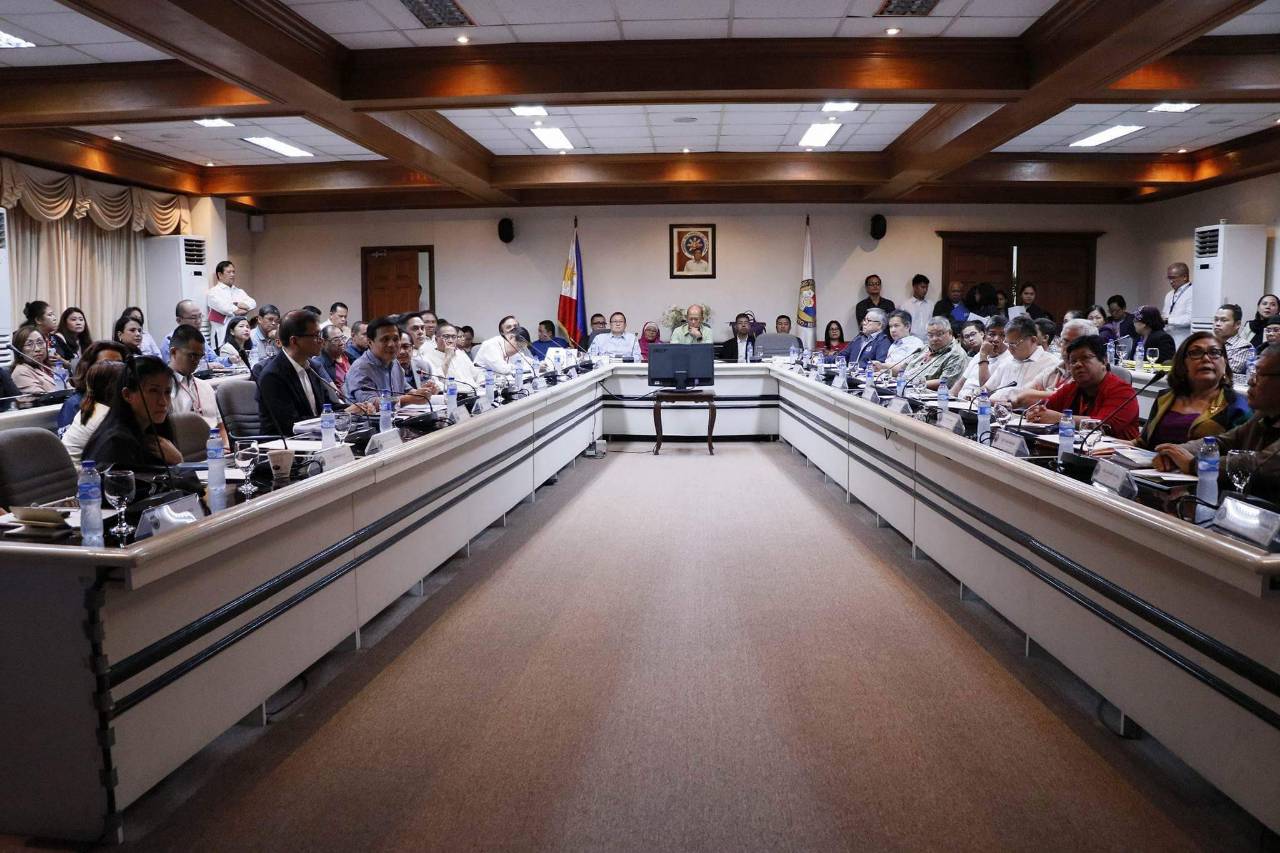
Credit: Philippine Information Agency
Quezon City, Metro Manila (18 October 2017) - The City Government of Marawi and the Provincial Government of Lanao del Sur, together with the Mindanao State University present the Comprehensive Rehabilitation, Reconstruction and Recovery Plan (CRRARP) or master plan for the city of Marawi.
Government begins preparing for recovery and rehabilitation
Task Force Bangon Marawi, meanwhile, has begun a damage and loss assessment in Marawi City. Five teams of various national and local government agencies were deployed to 24 of the city’s 96 barangays declared cleared by the military. The Government hopes to have its report on these barangays by the beginning of November, while assessments of other barangays will commence as the military completes its clearing operations in those areas. The damage and loss assessments, along with the human response needs analysis conducted in August, contribute to the Government’s post-conflict needs assessment. The task force has also received a joint recovery, rehabilitation and peacebuilding plan for Marawi City and Lanao del Sur, which will serve as the Government’s master plan. The plan includes components on reconstruction, housing, health, education, social welfare, economic recovery, and peace and order. As support to the Task Force Bangon Marawi, the UN is also working with the provincial and local governments in preparing an integrated recovery plan that includes business and livelihood activities and increasing access to financial resources for those affected by the conflict. Trainings on negotiation and mediation, and conflict analysis have also been provided to members of the academe and civil society organizations.
As Government, local NGOs and international partners continue to address the humanitarian needs of those displaced while directing more attention to their safe, voluntary return and transition to recovery, more information is needed on housing, land and property matters for returnees, as well as information on those who have already returned to ensure their basic needs continue to be met. Most humanitarian responders are currently only resourced to support the humanitarian response until December 2017, though it will be a long road ahead and many people continuing to require assistance to meet their immediate needs while they rebuild their lives.
While the needs of those staying in evacuation centres still require attention, people living with host families and in remote areas need to be prioritized for assistance. More focused support is also required for children with special needs, orphans, at-risk children, out-of-school youth and childheaded families.
Girls and young women are especially affected, with about a quarter to a third of the communities surveyed reporting incidents of sexual violence, early marriage and negative consequences for survivors of abuse.
Earthquake contingency planning workshop brings together ASEAN humanitarian partners
The heads of state of the ten ASEAN nations affirmed in September 2016 the declaration “One ASEAN One Response: ASEAN Responding to Disasters as One in the Region and Outside the Region” which aims to achieve faster response, mobilize greater resources and establish stronger coordination to ensure ASEAN’s collective response to disasters. The declaration also confirms that the ASEAN Coordinating Centre for Humanitarian Assistance (AHA Centre) is the primary regional coordinating agency on disaster management and emergency response, and recognizes its future role in enabling ASEAN to respond to emergencies outside of the region.
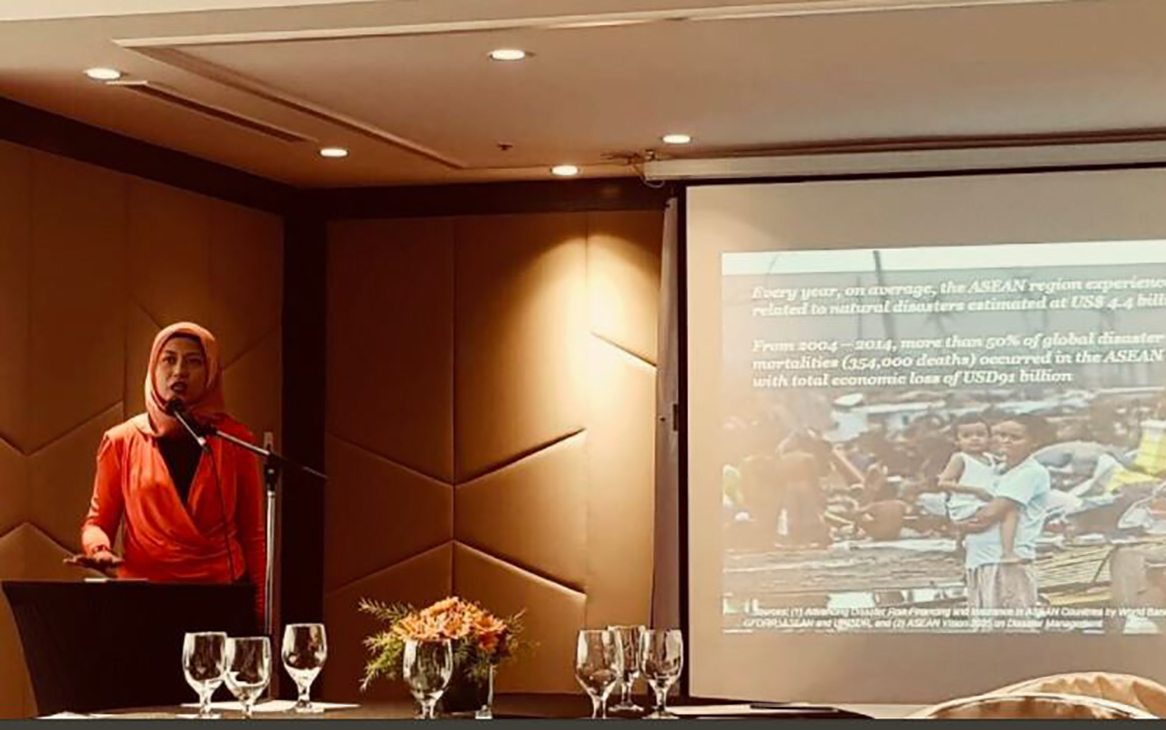
Manila, Philippines (10 October 2017) - Ms. Adelina Kamal, Executive Director of AHA Centre, briefs workshop participants on the regional coordination mechanism and ASEAN’s standby arrangements to support Member States on disaster response.
One of the concrete steps to implement the One ASEAN One Response strategy is the development of the ASEAN Joint Disaster Response Plan (AJDRP) to increase the speed and expand the scale of regional collective response, and enhance the solidarity of ASEAN in preparing for possible large scale emergencies in the region. The AJDRP identifies high priority assets and capacities which can be rapidly mobilized from among Member States for disaster response, such as assistance for search and rescue; water, sanitation and hygiene; health; food; non-food items; early recovery; logistics; emergency telecommunications; and expertise on humanitarian coordination, assessments and information management, and civil-military coordination.
In a bid to further prepare the regional organization to respond to mega-disasters, the AHA Centre and Office of Civil Defense (OCD) conducted on 10 to 11 October 2017 a workshop for the development of a regional contingency plan to prepare ASEAN Member States, the AHA Centre, and other ASEAN partners to respond effectively to a 7.2-magnitude earthquake affecting Metro Manila. In addition to the development of a regional plan, the workshop also aimed to review and strengthen the existing earthquake contingency plan of the National Disaster Risk Reduction and Management Council (NDRRMC) by assessing the existing capacities and gaps at the country level, and identifying the resources that could be provided by the ASEAN Member States and its partners.
The participation of OCHA in the OCD-AHA Centre workshop provided the Philippines Humanitarian Country Team (HCT) with insights on the current perspective on national and regional responses, which also underscores the need to have a common understanding not only of the impact of the disaster, but also the preparation and mitigation measures being undertaken by all concerned stakeholders. The HCT is similarly undertaking a contingency planning process to position itself where it could contribute positively towards a meaningful humanitarian response, with a strategy that includes agreement on protocols for the activation and rapid deployment of already established international tools and services. While the NDRRMC, through its Philippine International Humanitarian Assistance Cluster, has developed the operational guidelines for managing incoming international assistance, the protocols for offering/requesting assistance, whether within or outside country, have not been clarified yet.
The HCT encourages its clusters to work in close collaboration with their government counterparts to ensure that there is alignment of plans and agreement on responsibilities.
The One ASEAN One Response strategy is a joint disaster response plan that was developed to serve as framework in increasing the speed and expanding the scale of regional collective response
ASEAN symposium on strengthening convergence of humanitarian response
ICRC contributed this article.
In recognition of the important role of the ASEAN Institute for Peace and Reconciliation (AIPR), the International Committee of the Red Cross (ICRC) and the Office of the Presidential Adviser on the Peace Process (OPAPP) supported the AIPR symposium titled “Strengthening Convergences for Humanitarian Action in ASEAN” held in Manila on 2 and 3 October 2017.
Held within the Philippine chairmanship of the ASEAN on its 50th anniversary, the event was attended by around 170 policy-makers and peace practitioners from ASEAN member states, its dialogue partners, and civil society organizations from the region and beyond. It served as a venue for all concerned stakeholders to advocate for humanitarian access to people in need in conflict and for respect of humanitarian values within the region.
“The symposium was an opportunity to highlight the importance of promoting respect for rules that preserve the human dignity of victims in conflict and other situations of violence—and the need to uphold the responsibility to act collectively,” said Pascal Porchet, ICRC Head of Delegation to the Philippines.
The interactive discussions covered, among others, the protection challenges related to conflicts and ethnic tensions in the region, and the challenges faced in translating humanitarian principles and religious values into practice, with a particular focus in strengthening protection for vulnerable groups. The symposium identified best practices in enhancing respect and appreciation for the principles of humanitarian law.
In her closing remarks, Permanent Representative of the Philippines to ASEAN and Chair of the AIPR Governing Council, Elizabeth Buensuceso commended the symposium’s participants for providing inspiration on how everyone can give active contribution towards peace and cooperation. She underscored that “despite the all-too frequent gloomy and devastating news of trouble, conflict and hatred in the world today, there are religious leaders, academics, humanitarian workers, legal and law enforcement officers, government officials, diplomats, health-care providers, educators and other segments of civil society that are focused on the upliftment of human dignity and the provision of humanitarian assistance to every human life, particularly that of the vulnerable, the weak-- -those people who have nothing to do with the conflict in the first place.”
The AIPR symposium was also supported by the Governments of Norway and Switzerland. The ASEAN Institute for Peace and Reconciliation is the ASEAN institution for research activities on peace, conflict management and conflict resolution based in Jakarta, Indonesia.
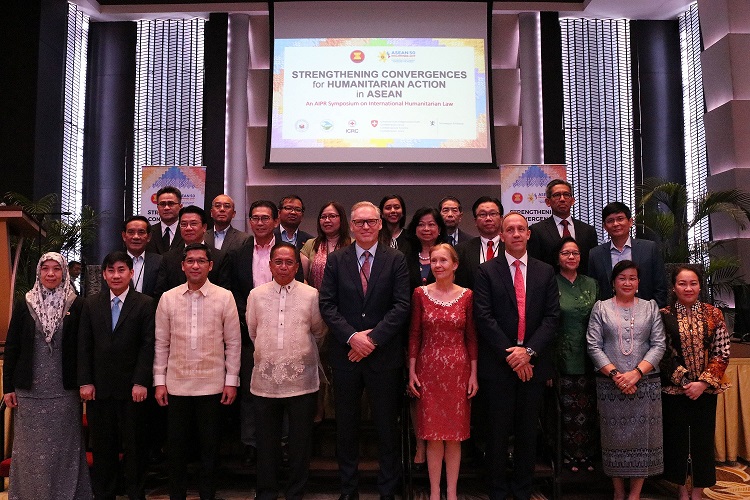
Ermita, Manila (2 October 2017) - The AIPR Governing Council led by its Chair, Permanent Representative of the Philippines to ASEAN Elizabeth Buensuceso, and the members of the AIPR Advisory Board, OPAPP Secretary Jesus Dureza. Also in the photo are Swiss Ambassador to the Philippines Andrea Reichlin, Norwegian Ambassador to the Philippines Erik Førner, Department of Foreign Affairs Undersecretary for Civilian Security and Consular Concerns, Jose Luis Montales, and ICRC Head of Delegation to the Philippines Pascal Porchet.
“The symposium was an opportunity to highlight the importance of promoting respect for rules that preserve the human dignity of victims in conflict and other situations of violence— and the need to uphold the responsibility to act collectively,” said Pascal Porchet, ICRC Head of Delegation to the Philippines.